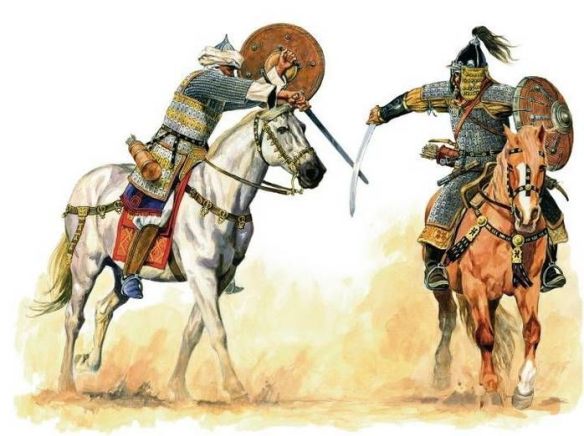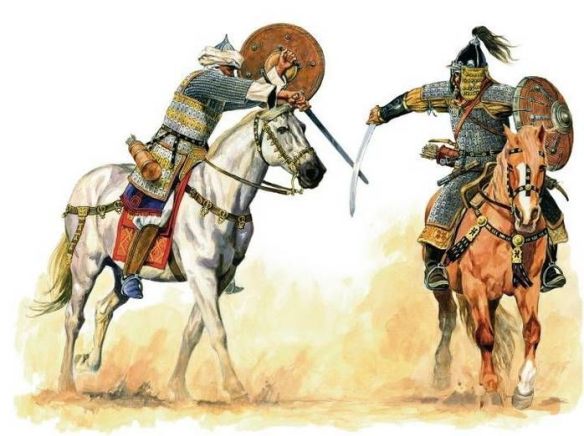
The Battle of Ayn Jalut (1260) set the tone for almost all assessments of the Ilkhan-Mamluk War, particularly regarding its implications for the Crusader States. Mongol leader Hulegu, the grandson of Genghis Khan, originally invaded Syria with a force that might have numbered as many as 120,000. The Ayyubids of Syria were incapable of offering much resistance to this military machine, which had already exterminated the Abbasid caliphate, conquered Iraq and Iran, and put an end to the Assassins by capturing and executing Hassan ibn al-Saabah (the Old Man of the Mountain). Hulegu’s plan was to push southward and conquer Egypt, which was experiencing a turbulent shift that would end Ayyubid rule and give rise to the Mamluk Sultanate. The invasion of Egypt, however, was interrupted by the death of the Great Khan Mongke (Mangu Khan), as well as the intrigues of Hulegu’s uncle Batu Khan, leader of the Golden Horde. Hulegu was forced to return to Azerbaijan with the bulk of the Mongol army, leaving a small detachment of troops in Syria under the command of his general Kitbugha, whose task was to hold Syria and prepare for the invasion of Egypt once interkhannate conflicts had been resolved. The Mamluks decided to take the war to the Mongols and negotiate with the Crusader States. Although the Latins were technically neutral, they not only granted the Mamluks free passage through their territory to engage the Mongols but also provided them with supplies. The forces clashed at Ayn Jalut. The Mamluks had nearly every tactical advantage: surprise (Kitbugha vastly underestimated the size of the Mamluk force), terrain (Mamluks had high ground), and positioning (the Mongols were facing the sun). The Mamluks are also believed to have enjoyed an overwhelming numerical superiority, though this belief has recently been challenged. In the end the Mongols were surrounded, Kitbugha killed, and the rest of the Mongols cut down as they tried to flee uphill. Traditionally, this battle has been seen as the definitive Mamluk “check” on Mongol expansion into the eastern Mediterranean. It also allowed the Mamluks to fill the power vacuum created in Syria by the Mongol attack, clearing a path to the unification of Egypt and Syria under an aggressive and organized state.
Ayn Jalut has also been seen as a microcosm in which the strengths of the Mamluk Sultanate and the weaknesses of the Ilkhans can be observed with great clarity. The Mamluks were forging a highly centralized (by medieval standards) military machine that enjoyed the home-court advantage. Their military tactics and methods, moreover, were well suited to the environment. They could focus all of their attention on threats in the region. The Ilkhans, however, were fighting a battle on the periphery of their empire. Events in Persia were of greater concern to them; Syria, Palestine, and Egypt were secondary (though still important) considerations. The Ilkhans were frequently forced to disengage from Syrian campaigns to focus their attention elsewhere. Nor was this emphasis the only reason the Ilkhans could not maintain a constant presence. Syria did not offer enough pastureland for the Ilkhans’ horses, and the cavalry was the sine qua non for effective Mongol military operations. When all of these factors are tallied, it becomes clear that the Ilkhans could not commit the necessary men for the requisite period of time to win a Syrian war. This deficiency can be seen in Ayn Jalut: the initial conquest was sudden and severe, but ultimately the area was defended by a small detachment. The same results can be gleaned from periodic Mongol returns to Syria such as those of 1280, 1299, 1301, and 1303.
There is much merit to these arguments, and it seems clear that the Ilkhans were incapable of maintaining a constant presence in Syria; but was a Mongol-Western alliance necessary for altering the balance of power in the region in favor of the Crusader States? Rather than focusing on the “lessons of Ayn Jalut” and using that battle as the paradigm by which to interpret the Mongol presence in the region, one should focus on the lessons of the Battle of Horns (1281) and the alternative paradigm it offers. This engagement has never received the attention that Ayn Jalut has enjoyed, but in many respects it reveals much more about the impact of the Mongols on the region than Ayn Jalut.
The Battle of Horns was the culmination of the Ilkhan invasion of Syria. After an expeditionary force sacked Aleppo and withdrew, a Mongol army of fifty thousand (complemented with non-Mongol contingents numbering up to thirty thousand) launched a full-scale invasion of Syria under the command of Mongke-Temur. As in the battle of Ayn Jalut, the Franks remained neutral (save a few renegades) because of the treaty in effect between Antioch ruler Bohemond VII and the sultan Qala’un. On 29 October 1281 the Ilkhan and Mamluk armies fought outside the city of Horns. The battle was even more pitched than that waged at Ayn Jalut. Both sides were convinced they were losing until Mongke was wounded and Mongol morale was disrupted. The Mamluk victory, however, was a pyrrhic one. Mamluk losses were devastating, so much so that an Armenian observer dubbed their victory a resounding defeat. The blow to the Mamluk army was crippling; Qala’un had to rebuild the Egyptian army before he could take any further action against his other enemies. A notable exception to this situation was Qala’un’s assault on Armenia. The objective was twofold and of the utmost importance to the Sultanate. First, Armenia had to be punished for its cooperation with the Mongols to deter any possible repetition of Horns. Any joint activities between Christian powers and Mongols were a grave threat to Egyptian power. Second, the Armenian city of Ayas was an important hub for the slave trade. Auxiliaries could be quickly recruited from Bedouin tribes, but the backbone of the Egyptian army was the Mamluks, who could only be recruited from the slave markets. For the duration of their lengthy and effective training, Mamluks were slaves and, according to Islamic law, Muslims could not be slaves. So young slaves, mostly of Turkish origin, had to be purchased and then trained to replenish the most effective part of the Egyptian army. Although it was difficult for any medieval army to recover from massive losses, this problem was doubly so for the Mamluk military machine.
The main lesson to be learned from Ayn Jalut is that the Mongols were incapable of maintaining a strong military presence in Syria. The lesson of Horns is that the Mongols could inflict an incredible amount of damage in a short period of time. Even though they lost the battle, the Mongols dealt a crippling blow to the Mamluks, and they did it with no real Latin assistance. The Mamluk army was rendered incapable of taking any decisive military action against the Crusader States. The destruction of Qala’un’s army, and the time needed to reconstitute it, provide a much better explanation than treaties for the extended lease on life the Crusader States were granted. Additionally, it created a power vacuum in Syria. The initial Mongol conquest of Syria prior to Ayn Jalut created a similar vacuum—one that was filled by the Mamluks at the expense of the Ayyubids. Following Horns, the Mamluks were incapable of substantively filling that vacuum. Naturally, the barons of the Crusader States were in no position to do so either, but it certainly created a window of opportunity for making substantial gains in the region. If a traditional, major Western Crusade could have struck shortly after Horns, it would have found an already defeated enemy. There is every reason to believe that the entire balance of power in the region would have shifted. Nor is it beyond the realm of possibility that such a Crusader host would have been able to march on Alexandria and Cairo and in so doing create a Latin Egypt. Since Iran and Iraq now formed the center of the Ilkhan empire, Egypt could expect no help for the Islamic heartland in the Near East.
–TODD MARX, CONCORD, NEW HAMPSHIRE
